"If you ever drop your keys into a river of molten lava, let 'em go, because, man, they're gone." -Jack Handey
Take a look at our home planet, Earth, and one of the things you'll notice is that over 70% of the surface is coated in water.
We all know why this is, of course: it's because the Earth's oceans float atop the rocks and dirt that make up what we know as land.
This concept of floatation and buoyancy -- where the less dense objects rise above the denser ones, which sink to the bottom -- does much more than just explain the oceans.
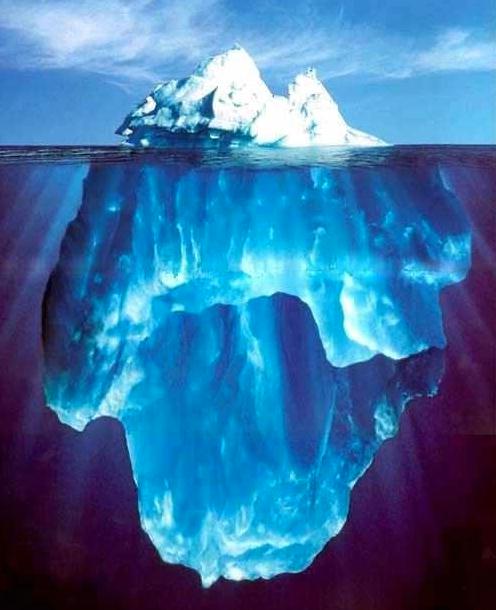
This same principle that explains why ice floats on water, why a helium balloon rises through the atmosphere or why stones sink to the bottom of a lake, also explains why the Earth is layered the way it is.
The least dense part of the Earth, the atmosphere, floats atop the watery oceans, which in turn float atop the Earth's crust, which lies above the more dense mantle, which itself cannot sink down into the densest section of the Earth: the core.
Ideally, the most stable state the Earth could conceivably be in is one that was perfectly layered like an onion, with the densest elements all towards its center, with each outward layer progressively made up of less dense elements. In fact, each earthquake that occurs on Earth is actually the planet moving one step closer towards that ideal state.
And this explains the structure of not only the Earth, but all of the planets, if you remember where all of these elements came from in the first place.
When the Universe was very young -- only a few minutes old -- practically the only elements that existed were hydrogen and helium. All the heavier ones were made in stars, and it was only when these stars died that these heavy elements were recycled back out into the Universe, allowing new generations of stars to form.
But this time, a mix of all of these new elements -- not just hydrogen and helium, but carbon, nitrogen, oxygen, silicon, magnesium, sulphur, iron and more -- goes into forming not only new stars, but a protoplanetary disk around each of those stars.
The outward pressure from the newly forming star preferentially pushes the lighter elements out towards the outer parts of the solar system, while gravity causes instabilities in the disk to collapse and form what will become planets.

In the case of our Solar System, the four innermost worlds are the four densest planets in our Solar System, with Mercury being composed of the densest elements, all of which were unable to gravitationally hold on to large amounts of hydrogen and helium.
But the outer planets, being both more massive and farther away from the Sun (and hence receiving less radiation), managed to hang on to large amounts of these ultra-light elements, and formed gas giants.
Each of these worlds, much like the Earth, has -- overall -- the densest elements concentrated at the core, with lighter ones forming progressively less and less dense layers surrounding it.
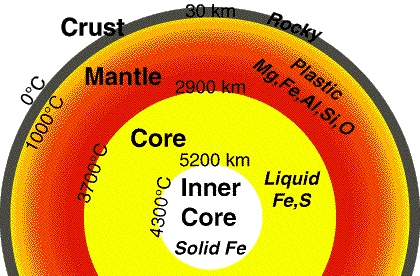
It should come as no great surprise that iron, the most stable element and the heaviest element made in great abundance outside of supernovae, is the most abundant element in the Earth's core. But it may surprise you to learn that, in between the solid inner core and the solid mantle, lies a liquid layer more than 2,000 kilometers thick: the Earth's outer core.
Much like the disgusting gum your grandma used to carry around, the Earth has a huge liquid layer inside of it, containing 30% of its mass! The way we know that the outer core is liquid is quite brilliant: from the seismic waves produced from earthquakes!
There are two different types of seismic waves produced in earthquakes: the primary compression wave, known as the P-wave, which works like a pulse through a slinky,
and the secondary shear wave, known as the S-Wave, which works like waves on the surface of the sea.

Seismic monitoring stations all over the world are capable of picking up both P- and S-waves, but S-waves do not travel through liquid (they are attenuated, though), while P-waves not only do travel through liquid, they are refracted!
As a result of this, we can learn that the Earth has a liquid outer core, a solid mantle exterior to that, and a solid core interior to it! So that's how come the Earth has the heaviest, densest elements at its core, and how we know its outer core is a liquid layer.
But why is the outer core liquid? Like all elements, whether iron is solid, liquid, gas or "other" depends on both the pressure and temperature of the iron.
Iron, however, is much more complicated than many elements you may be used to. Sure, it can take on a variety of crystalline solid phases, as shown above, but we're not interested in these normal pressures, shown in the diagram above. We're going all the way down into the core of the Earth, where the pressure is millions of times what it is at sea level. What does the phase diagram look like for excessive pressures like that?
The wonderful thing about science is that even when you don't know the answer off the top of your head, chances are, someone's done the research where you can find the answer! In this case, Ahrens, Collins and Chen, 2001 have the answer we're looking for!
While this diagram shows tremendous pressures -- up to 120 GigaPascals -- it's important to remember that our atmosphere has only 0.0001 GigaPascals, while the inner core experiences pressures of an estimated 330-360 Gpa! The upper solid line represents the boundary between molten iron (above) and solid iron (below). But notice how, right at the very edge of the solid line, it takes a sharp upwards turn?
At 330 GigaPascals, it takes a tremendous temperature, something comparable to those found at the surface of the Sun, to melt iron. Those same temperatures, however, at lower pressures, will easily keep iron in its liquid phase, while at higher pressures will see iron form a solid. What does this mean for the core of the Earth?
It means that, as the Earth cools over time, its interior temperature drops, while its pressure remains constant. In other words, when the Earth first formed, it's very likely that the entire core was liquid, and as it continues to cool, the inner core continues to grow! And as this happens, because solid iron has a higher density than liquid iron, the Earth will contract slightly, necessitating what?
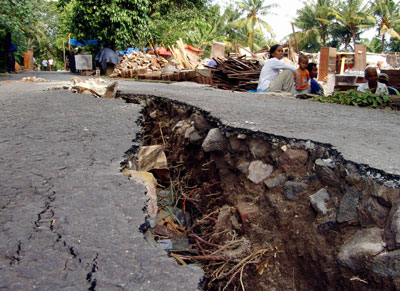
Earthquakes!
So the Earth's core is liquid because it's hot enough to melt iron, but only in places where the pressure is low enough. As the Earth continues to age and cool, more and more of the core becomes solid, and when it does, the Earth shrinks a little bit!
If we want to look far into the future, we can expect to eventually acquire features like those found on Mercury!
Because it's so small, Mercury has already cooled and contracted a tremendous amount, and has hundred-mile-long cracks in it from where it was forced to contract due to this cooling!
So why does the Earth have a liquid core? Because it hasn't finished cooling yet! And every earthquake you feel is the Earth getting just a little bit closer to its final, cooled-off, solid-all-the-way-through state!
(Don't worry, though, the Sun will explode and you and everyone you know will be dead for a really long time before that ever happens!)
- Log in to post comments



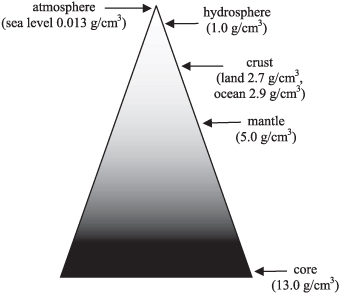


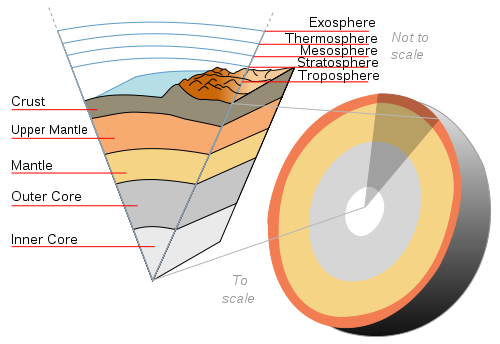
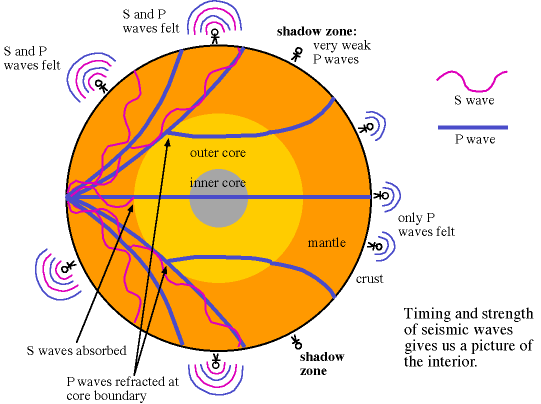

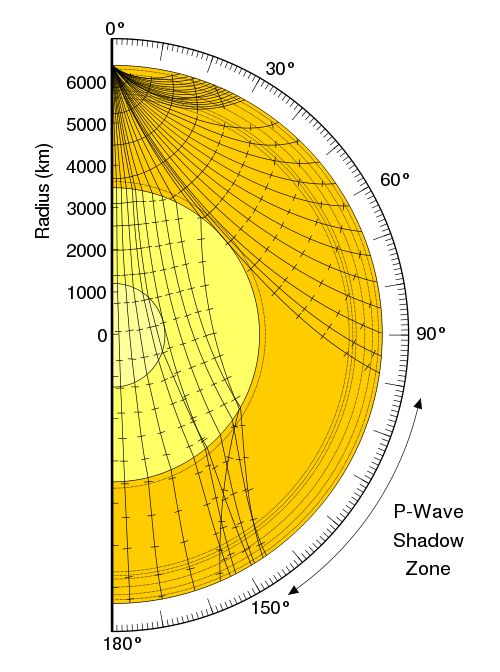

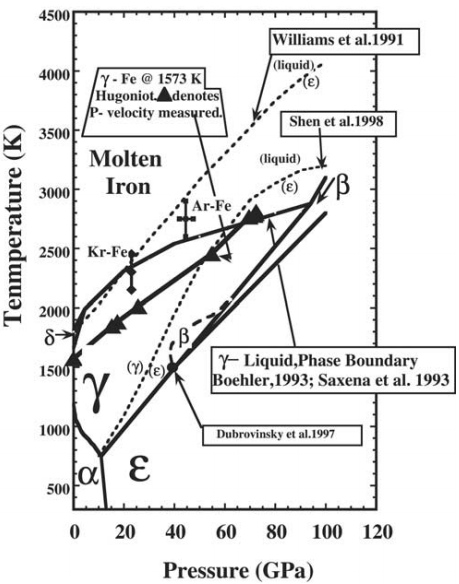


Iâve recently started a web site, the information you offer on this website has helped me greatly. Thank you for all of your time & work
Wow. I did not know that the liquid core cools and solidifies, growing the solid core and shrinking the core over all!
Put on your geophysics hat, Ethan. Your article sparked some questions.
At what rate is the shrinkage happening? How much does core shrinkage contribute to earthquakes compared to other causes such as mantle convection? Can earthquakes from this cause be differentiated from plate-tectonics earthquakes by their depth?
Which form(s) of iron is the inner coreâBeta, Gamma, Epsilon? What are the magnetic properties of the various forms of Iron? Does it contribute to the Earth's magnetic field? Do magnetic pole reversals get imprinted on the inner core as they do on mid-oceanic ridges? How does the history of core cooling and the resulting qualitative changes in the core structure correlate with the history of magnetic field reversals?
Whoa, making as direct a connection between core crystallization and earthquakes as done here is a stretch. Earthquakes are fundamentally in response to the release of stress within the lithosphere, which is certainly related to a cooling planet, but not because of any resultant volume change. The buildup of lithospheric stress is primary a function of gravitational instability.
A nice summary on the state of the Earth's interior!
It's worth noting, though, that the shrinkage of planet Earth is not nearly sufficient to account for the nature of Earth's seismicity. Mantle convection and associated plate motions are dominantly responsible for earthquakes.
When I think of earthquakes I think of plate tectonics. The Earth recycles its oceanic crust in a couple of hundred million years through seafloor spreading and subduction. Any additional amount of subduction to accommodate the shrinking of the core has to be miniscule compared to that!
On the topic of flotation and buoyancy: What's wrong with the artist's conception of an iceberg?
Charles, Will and Joe,
It is an eventually type of connection, not an immediate one, of course. But with every earthquake we have, the planet's moment of inertia shrinks due to its density rearranging itself, and our rate of rotation (due to conservation of angular momentum) speeds up by just a tiny bit!
The Earth is full of surprises and intricacies, and yet the overall physics is somehow as simple as it could possibly be!
The progressive solidification of the core may contribute to the magnetic field in this way: the solidification releases large amounts of energy (latent heat of fusion) which, combined with any energy released by radioactive decay of heavy elements in the core, has to be carried away by convection within the liquid outer core.
The combination of convection and the rotation of the earth means that most of the outer core is in motion in a set of huge cyclic flows - and molten iron is a good conductor of electricity, so the whole system becomes a set of huge dynamos, converting a fraction of the mechanical energy resulting from convection into electricity, and then back to heat, producing the magnetic field which itself sustains the process of electricity generation.
(Note that the fact that it is (mostly) iron is completely irrelevant - any liquid conductor will do; the iron in both the inner and outer core is much too hot to show any ferromagnetic properties. I believe molten sodium has been used in lab-scale experiments on fluid dynamo systems, but I can't find the reference.)
Pole reversals and other magnetic anomalies arise from the fact that the convection and dynamo processes are chaotic. Pole reversals would not be imprinted on the inner core since it is too hot; also, if they were, they would tend to establish a preferred polarity of the magnetic field, whereas the evidence is that there is no preferred polarity. The chaotic nature of the process also explains the unpredictability of pole reversals (which can be anything from about 50k to 50m+ years apart - don't pay any attention to horror stories about how we're overdue for one now).
"the planet's moment of inertia shrinks"
But is this speed up equal to what one get's from core solidification? The commentator's seem to imply that you may get much more speeding up because maybe it happens to be the case that presently the convection (continental drift and all) drives the mantel and crust towards the north and south and thus a little closer to the axis.
Oh, great. Now I have to start explaining things to the 7-year-old daughter all over again....
More strange perspectives: In addition to the inner core growing directly by iron and nickel freezing at the boundary, iron crystals can form at the top of outer core and gently rain down through the outer core onto the boundary.
Also, at the boundary of the mantle and the outer core, there are likely upside-down mountains poking down into the liquid. There's some extreme mountaineering opportunities for you.
Thank you for the clarifications.
I'm not so sure that all earthquakes cause a decrease in the Earth's polar moment of inertia. Plate-tectonics-driven orogeny would cause earthquakes, too. Surely the Rockies and the one-great Appalachians caused some rumbles as they emerged. The Himalayas are still rumbling as they lift.
Sascha, mantle convection happens at a very slow rate. I believe that the effects of rotation are insignificant in comparison. Also, that convection is all over the planet, fairly independent of whether it moves things north or south. The middle of the Atlantic, for instance, is a really long east-west spreading center and sections of the west coast of the Americas are east-west subduction zones.
Andrew, heh. No, I'm not concerned about an imminent pole reversal. It was interesting to read one researcher's summary of reviewing centuries of British Admiralty charts of magnetic anomalies. They appear to be increasing ⦠slowly.
How many years can we provide for our energy needs just by drilling and tapping earth heat?
We are just sitting on it and it´s there.
Geothermal energy is practical on small scales and in specific locations, but not as a large component of primary power generation.
Human total power consumption is something on the order of 20 TW, while geothermal heat flux is something like 40 TW. But at the surface, the geothermal heat profile is rarely conducive to efficient power extraction, which requires large temperature differences between the hot (source) and cold (sink) sides. The most optimistic possible figure for the extractable proportion would be something like 5%, so not more than about 10% of current energy needs could be met this way.
An important factor in Earth rotation rate throughout its history is tidal acceleration. (Usually a deceleration.)
Compare the Moon. When it formed it probably had only small rotation rate to begin with, and subsequently tidal accelereration slowed the Moon down to one revolution per month (this 1-on-1 state is called tidal lock).
Tidal lock is a final state; the Moon's rotation will remain in tidal lock with its orbit around the Earth.
It's possible to infer ancient rotation rates from the geological record of growth patterns. Under some circumnstances the geological record shows seasonal cycle, spring tide/low tide cycle and individual tide cycle.
From those cycles the number of days per year can be found.
As I understand it, according to paleo-rotation data around 500 million years ago there were about 420 days in a year.
Paleo rotation Source:
http://www.geo.ucalgary.ca/~wu/Goph681/EarthRotation.pdf
Does this take into account the heat generated by radioactive decay? When I took geology years ago I was surprised at how much of the Earth's core temperature was due to radioactivity.
From the figures I found, radioactive decay contributes on the order of 30 TW currently, with the remainder coming from actual cooling.
The part where it is said that cracks like those on Mercury will eventually form on Earth is quite misleading. Such cracks could eventually form, if we didn't have plate tectonics, which are the immediate source of our earthquakes. As argued above, the impetus for the motions of the plates is somewhat in dispute, though mantle currents do seem to have the advantage in both adherents and explanations/assumptions ratio. But I for one would appreciate if the original text could be edited to clarify that such giant cracks could only form (from cooling, anyhow) on a timescale that is glacial compared to the movement of the tectonic plates, which keep our lithosphere active & rejuvenated.
"On the topic of flotation and buoyancy: What's wrong with the artist's conception of an iceberg?
Posted by: Dan Milton"
C'mon Dan, don't keep us in suspension -
One thing that is wrong with the iceberg is that there is no discontinuity of iceberg shape at the waterline. Icebergs lose mass by melting, and that melting mostly occurs in the water. The widest spot is usually right at the water line. But that depends on how long the ice has been in the water.
Icebergs only form from glaciers and so must initially retain the shape of the piece of glacial ice they formed from. This glacier seems to be drawn as if it froze in situ, but it has the wrong shape.
I understand that the outer core of the Earth is liquid (iron and other elements) because it is at the outer coreâs pressure that the temperature can maintain the liquid phase of iron. The inner core is solid because at its pressure the temperature cannot melt iron. Why though does the increase in pressure cause an increase in melting point? It would make sense for the increase in pressure to cause more friction among iron atoms and raise the temperature itself. For example, when stars are just clouds of hydrogen and helium gas, they ignite because the immense pressure in the center causes more heat and friction, allowing for the star to ignite and begin fusing elements. So, why does the pressure raise melting point in the inner core?
GnG #20 asks:
Given a certain temperature, at a sufficiently high pressure iron is solid.
Actually this kind of question is best posted at a site like physicsforums.com
It is intuitive that temperature is a factor: heat is average velocity of the molecules. The hotter, the stronger the tendency to be liquid.
But how is pressure involved?
For comparison: there are types of material that are known to have two distinct crystallisation states, where one is more compacted than the other.
A tectonic plate that slides under another plate takes material to greater depths. Some geological phenomena are explained in terms of some material undergoing a recrystallisation, becoming denser in the process.
In the process of recrystalizing to a denser form work is done upon the material. Hence the denser configuration has a potential energy stored in it that is released again when the material goes to the less dense configuration.
(This can give rise to a runaway effect: rising material goes to a less dense form, increasing its buoyancy relative to surrounding material.)
For the Earth core iron I surmise the following:
For the solid iron of the core the Earth's pressure has done work upon it.
Contraction of a celestial body converts gravitational potential energy to another form of energy.
Without a process of solification contraction acts to increase (or at least sustain) internal heat.
With solidification some of the work done goes into a potential energy.
So in its own way the solification acts as an energy sink, so that the gravitational potential energy doesn't necessarily all convert to heat as the celestial body contracts.
One big problem I see with this argument is the use of a PURE Fe phase diagram. Phase diagrams and melting points are extremely sensitive to the presence of a second (or third etc) component and exhibit an array of phases depending on solubility.
I remember reading that Ni exists in significant quantities in the core. So it would probably be more appropriate to use the Fe-Ni phase diagram.
Scientists may be wrong in the concept that the inner core is the heaviest part of our planet Earth. Let me assume that orbiting a star there is a planet with the same size of the earth; such a planet is composed of liquid water only; an iron meteorite falls in it, Where would the meteor would stop? What distance from the surface would it stop moving? I am sure that the answer is not the center.
The inner core of the Earth is a huge mass of solid oxygen and the outer core is liquid oxygen. Liquid oxygen and solid oxygen are highly paramagnetic. Think open-minded, change wrong paradigm, please.
Lol thts cool lmao we should go jump in lava that would be awesome
Regarding the iceberg depiction, it looks to me that the iceberg should tip over onto it side. There is too much ice below the water to be seemingly balanced like that.
I like this info. And esspecially the pics.
I really like this picture & information.
Thanks that really helped a lot.
keep up the good work!!! :)
help me
I am on You Tube as the user name of my name. I am currently doing scientific research to determine if Earth was once a small star that became cool and formed into a planet. I have come to the current conclusion that when our sun becomes a white dwarf, Jupiter will then ignite and become the new sun in our solar system.
Here's the thing, Ken.
The scientific method and the scientific research are all about ways of finding out how you could be WRONG.
So, don't go looking for how you could be right, go looking for why you may be wrong.
Otherwise it isn't scientific research.
i love the earth and how it is. my school is working on a little thing
i really want to praise efforts of reseachers for getting keen in interior study of earth.me also keen to do so.........
Just reading around the net about earth's early beginnings. So I thought I'd just adds something I learned else where today, the cooling at the outer core is said to be about 100 degrees f per billion years. So that's 500 degrees cooling by the time the sun goes super nova and, as if that weren't bad enough, the galaxy Andromeda is due to collide with the milky way at about the same time.
Clearly there are some tough times ahead, so we'd better get cracking, with less than 5 billion years left on our clock it's foolish to worry about who rules what piece of land mass, or which after life scenario rules. Tempest Fugit!!!
wow that's really intresting
this information is very helpful for us to know about our earth.it has supported me in my study.
Lol physics FTW <3
The first phase diagram seems to have a wrong axis. To correspond with the next one and others on the net, it should be in 1000 atm (10^4 atm = 1 GPa)
you guys r so smart n cool lol jk but all these comments helped me alot!!!!!!
yes that's very interesting i believed that the heat in the earth was caused by radioactivity. so it is only partly because of radio activity ,and because the earth simply hasn't cooled off yet.
P Woodhead has a theory of a gas centered Earth core where the center of gravity is in the mantle, and proposes the metals are there supporting the dynamo.
you say that as the temperature of the core decreases the pressure remains the same but temperature and pressure are inversillay purportional if the temperature would decrease so would the pressure, or is this only true for ideal gasses?
if you reproduced the same iron core as in the earth could you reproduce these standards to replicate the electromagnetic fields that protect us from gamma radiation from the sun, thus protecting you from the effects of nuclear bombs and power?
why havent you posted my comment its been a couple days i need feedback for personal research
@ 45 This was July 4th weekend; some people take a well earned holiday, as Ethan did. :)
I get it but where did the molten lava / nuclear fussion come from. If there was space juke out there
Nuclear fusion came from the stars that synthesized the matter used to make the planetary mass.
Molten lava comes from silicon (quite common stellar output) that is heated a lot (by, for example, heating from friction as the matter forming a planet collapses to form a planet.
So, no, you didn't "get it". Work out why.
"Where would the meteor would stop?"
In the centre.
"What distance from the surface would it stop moving?"
One radius.
"I am sure that the answer is not the center. "
You're wrong.
what 2 things that increase morning from exterior to interior of earth
Can external gravitational waves increase heat at the earths core or speed up rotation.
Charles, yes it can. But there's not a lot of power in gravitaitonal waves, so you can ignore them for any actual work.